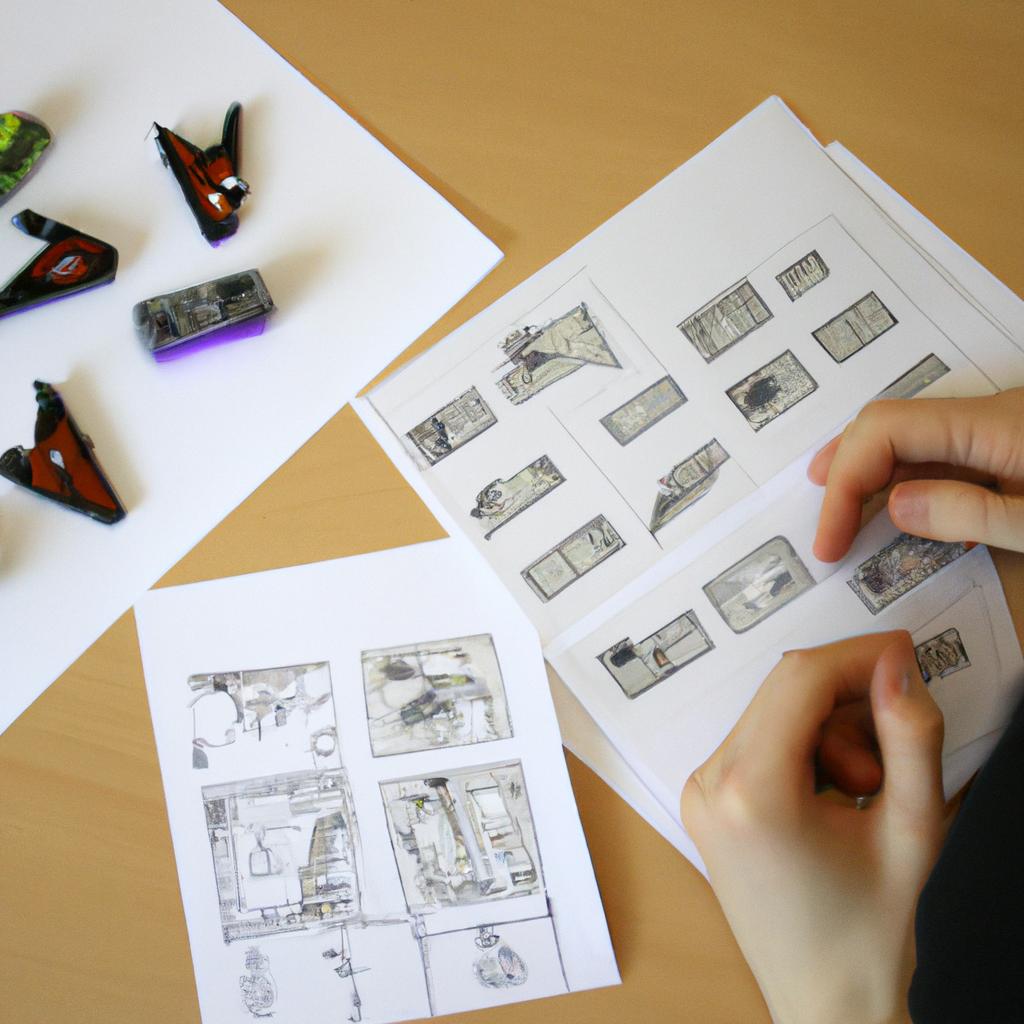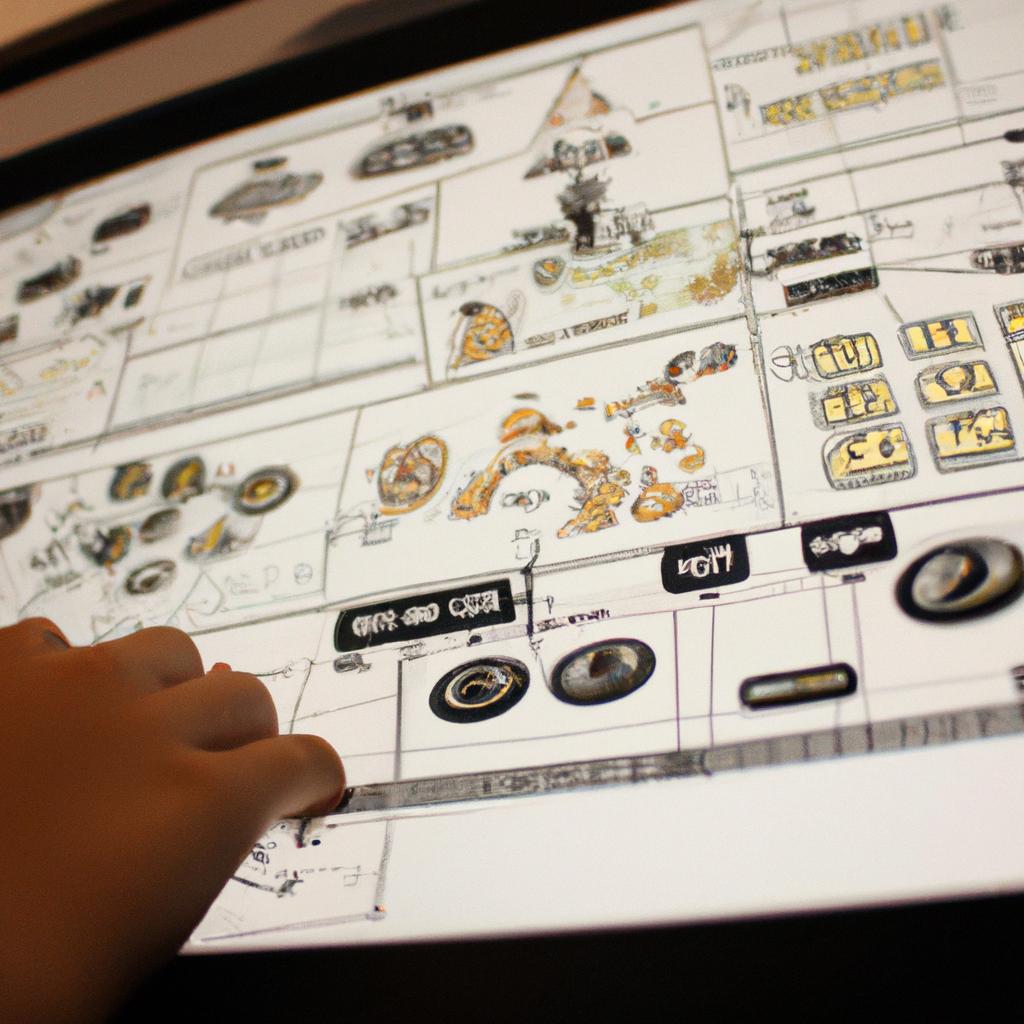Game Design in the Context of Games and Video Games

Game design is a multifaceted discipline that encompasses the creation, development, and implementation of interactive experiences in various contexts. This article explores game design in the context of games and video games, examining its role and significance within these mediums. By analyzing the intricate processes involved in designing games, we can gain insights into how different elements such as mechanics, aesthetics, and narrative contribute to an engaging player experience.
To illustrate this point, let us consider the case study of “The Legend of Zelda: Breath of the Wild.” Released by Nintendo for their flagship console, the Nintendo Switch, this critically acclaimed action-adventure game showcases exemplary game design principles. The open-world exploration combined with intuitive gameplay mechanics allows players to immerse themselves fully in a vast virtual landscape filled with quests, puzzles, and challenges. The seamless integration of environmental storytelling further enhances the player’s engagement by creating a sense of discovery and wonder. Through deconstructing such examples, we can delve deeper into understanding how effective game design shapes players’ interactions with digital media.
In order to comprehend the intricacies of game design within games and video games alike, it is essential to explore key concepts such as user experience (UX), player motivation, and ludology—the study of play. By doing so, we can gain a comprehensive understanding of how to create compelling and enjoyable gaming experiences.
User experience (UX) encompasses the overall experience that players have when interacting with a game. It involves factors such as ease of use, intuitiveness of controls, visual aesthetics, audio design, and how well the game meets the player’s expectations. Game designers must consider UX throughout the entire development process to ensure that players have a seamless and satisfying experience.
Player motivation is another crucial aspect of game design. Understanding what motivates players to engage with a game and continue playing is essential for creating captivating experiences. This can include elements such as rewards, progression systems, challenging gameplay, social interaction, and storytelling. By incorporating these motivating factors into a game’s design, developers can keep players engaged and invested in the experience.
Ludology, or the study of play, examines games from a theoretical perspective. It explores concepts such as game mechanics, rules, strategies, and player interactions within virtual worlds. By studying ludology, game designers can analyze how different mechanics work together to create engaging gameplay loops and foster meaningful player experiences.
In summary, effective game design requires an understanding of user experience (UX), player motivation, and ludology. By considering these key concepts throughout the development process and analyzing successful examples like “The Legend of Zelda: Breath of the Wild,” game designers can create immersive and enjoyable gaming experiences that captivate players’ attention.
Understanding the mechanics behind a game
Understanding the Mechanics Behind a Game
Games, whether they are traditional board games or modern video games, have one thing in common – mechanics. These mechanics refer to the rules and systems that govern how the game functions and how players interact with it. To truly understand a game, it is essential to dive into its mechanics and explore their intricacies.
To illustrate this point, let’s consider a hypothetical example of a popular strategy video game called “Empire Builder.” In this game, players take on the role of powerful leaders who aim to build and expand their empires. The mechanics of Empire Builder include resource management, strategic decision-making, and diplomacy. By carefully managing limited resources, making calculated decisions based on available information, and negotiating alliances with other players, individuals can strategically grow their empires while outsmarting opponents.
- Resource Management: Players must allocate limited resources effectively to ensure the growth and sustainability of their empire.
- Strategic Decision-Making: Every move requires careful consideration as choices made early in the game can have long-term consequences.
- Diplomacy: Building alliances or forging rivalries with other players impacts overall gameplay dynamics.
- Competition: Competing against other players adds an element of challenge and excitement.
Additionally, we can present key aspects of Understanding Game Mechanics through a table:
| Mechanics | Description |
|---|---|
| Resource Management | Allocate resources efficiently for optimal gameplay |
| Strategic Decision-Making | Make thoughtful choices based on current circumstances |
| Diplomacy | Interact with others through negotiation and alliance-building |
| Competition | Engage in challenges against fellow players |
By delving into these various components within the context of Empire Builder or any other game, we gain insight into what makes them engaging and captivating experiences. Understanding mechanics allows us to appreciate how each aspect contributes to the overall gameplay and helps us better comprehend the designer’s intentions.
Transitioning into the subsequent section about “Designing levels that challenge and engage players,” we can note how a thorough understanding of game mechanics lays the foundation for level design. By comprehending how different mechanics interact, designers can create well-balanced and engaging challenges that keep players immersed in the gaming experience.
Designing levels that challenge and engage players
Understanding the mechanics behind a game is crucial for effective game design. By delving into the intricacies of how games function, designers can create more engaging and immersive experiences for players. In this section, we will explore the process of designing levels that challenge and engage players, taking inspiration from successful examples.
One real-life case study that exemplifies Effective Level Design is the popular video game “Super Mario Bros.” Developed by Nintendo, this classic platformer features meticulously designed levels that gradually increase in difficulty as players progress through the game. The early levels serve as tutorials to familiarize players with basic mechanics such as jumping and collecting power-ups. As the player advances, new obstacles and enemies are introduced, requiring greater skill and strategy to overcome.
When designing challenging yet enjoyable levels, there are several key considerations:
- Progressive Difficulty: Levels should start easy and progressively introduce new challenges to ensure a gradual learning curve for players.
- Balanced Pacing: Varying the pace of gameplay helps maintain player engagement. Alternating between intense action sequences and calmer moments provides opportunities for strategic thinking or exploration.
- Reward System: Incorporating rewards such as collectibles or unlockable content motivates players to tackle difficult sections. These rewards provide a sense of accomplishment and encourage continued play.
- Intuitive Design: Levels should be intuitively laid out so that players can easily understand where they need to go or what actions they need to take. Clear visual cues or subtle hints guide players without explicitly telling them what to do.
To illustrate these concepts further, consider the following table showcasing different elements found in well-designed levels:
| Element | Description | Emotional Response |
|---|---|---|
| Challenging | Presents tough obstacles | Excitement |
| Surprising | Introduces unexpected twists | Surprise |
| Rewarding | Provides satisfying achievements | Satisfaction |
| Interactive | Encourages player experimentation | Engagement |
By incorporating these elements into level design, game designers can create captivating experiences that challenge and engage players.
[Transition] Building upon successful level designs lays the foundation for creating a seamless and enjoyable user experience.
Creating a seamless and enjoyable user experience
Designing levels that challenge and engage players is a fundamental aspect of game design. By creating well-crafted levels, game developers can provide an immersive and enjoyable experience for players. One example of this is the popular video game “Super Mario Bros.” In this game, each level presents unique obstacles and enemies that progressively increase in difficulty, keeping players engaged and motivated to overcome challenges.
To effectively design challenging and engaging levels, there are several key considerations to keep in mind:
-
Progressive Difficulty: Levels should be designed with a gradual increase in difficulty as players progress through the game. This allows them to gradually develop their skills and adapt to new challenges without becoming overwhelmed.
-
Balanced Gameplay: It is important to strike a balance between difficulty and fairness. Levels should offer a fair chance for success while still providing a sense of challenge. Unfair or overly difficult sections may frustrate players and lead to disengagement.
-
Reward System: Incorporating rewards throughout the gameplay experience can enhance player engagement. These rewards can include power-ups, collectibles, or unlocking new abilities that incentivize players to explore further.
-
Variety: To maintain player interest, levels should feature diverse environments, mechanics, and objectives. Introducing new elements keeps the gameplay fresh and prevents monotony.
| Level Design Considerations | Examples |
|---|---|
| Progressive Difficulty | Gradually increasing enemy strength |
| Balanced Gameplay | Providing checkpoints after challenging sections |
| Reward System | Unlocking bonus content upon completing optional objectives |
| Variety | Changing weather conditions throughout different levels |
By considering these factors when designing levels, developers can create an engaging gameplay experience that captivates players’ attention from start to finish.
Transitioning into the next section about crafting narratives that immerse players in the game world, it is essential for designers not only to focus on gameplay but also on creating a compelling storyline. By integrating narratives into the game design, players can further immerse themselves in the virtual world and establish an emotional connection with the characters and events within it.
Crafting narratives that immerse players in the game world
Building on the foundation of creating a seamless and enjoyable user experience, game designers must also focus on Crafting narratives that immerse players in the game world. By developing compelling stories and engaging characters, designers can captivate players and enhance their overall gaming experience.
To illustrate this point, let’s consider the popular video game “The Witcher 3: Wild Hunt.” In this immersive open-world RPG, players assume the role of Geralt of Rivia, a skilled monster hunter navigating a morally complex fantasy realm. The narrative is rich with choices that have consequences, allowing players to shape their own journey within the game.
Crafting an immersive narrative involves several key considerations:
-
Character Development:
- Creating well-rounded characters with distinct personalities and motivations.
- Giving characters depth through backstory and personal growth throughout the game.
- Allowing players to form emotional connections with these virtual personas.
-
Storytelling Techniques:
- Employing various storytelling devices such as cutscenes, dialogue trees, and in-game events.
- Balancing exposition with gameplay to maintain player engagement.
- Incorporating plot twists or unexpected developments to keep players intrigued.
-
World-Building:
- Designing detailed environments that reflect the game’s lore and setting.
- Integrating elements like architecture, landscapes, and cultural nuances to create an authentic atmosphere.
- Providing opportunities for exploration and discovery within the game world.
-
Player Agency:
- Offering meaningful choices that impact both immediate outcomes and long-term consequences.
- Allowing players to shape the direction of the story based on their decisions.
| Pros | Cons |
|---|---|
| Immersive storytelling | Risk of overwhelming players |
| Emotional connection with characters | Difficulty maintaining pacing |
| Engaging plot twists | Challenges in balancing player agency |
| Sense of exploration and discovery | Complexity in world-building |
By focusing on these aspects, game designers can create narratives that not only entertain but immerse players in the virtual worlds they inhabit. The combination of well-developed characters, captivating storytelling techniques, detailed world-building, and meaningful player agency contributes to a more engaging gaming experience.
With the foundation laid for crafting immersive narratives, the next step is Prototyping game ideas to test their feasibility.
Prototyping game ideas to test their feasibility
Crafting narratives that immerse players in the game world is an essential aspect of game design. By creating compelling storylines and characters, game designers can captivate players’ attention and enhance their overall gaming experience. For instance, consider a hypothetical scenario where a player embarks on a thrilling adventure as a young archaeologist exploring ancient ruins. Through well-crafted narrative elements such as hidden clues, mysterious artifacts, and unexpected plot twists, the player becomes fully immersed in the game world.
To effectively craft immersive narratives, game designers must consider several key principles:
- Character development: Designers should create multidimensional characters with relatable motivations and personalities to establish emotional connections between players and the virtual world.
- World-building: Developing rich environments with intricate details, backstories, and consistent rules helps players feel like they are truly part of the game’s universe.
- Pacing: Balancing moments of tension, excitement, drama, and relaxation throughout the storyline keeps players engaged while allowing for breaks to prevent overwhelming them.
- Player agency: Allowing players to make meaningful choices within the narrative empowers them and enhances immersion by making them feel responsible for shaping their own experiences.
In addition to crafting immersive narratives, prototyping game ideas is crucial for testing their feasibility before full-scale production. Prototyping serves as a fundamental step in refining gameplay mechanics and identifying potential issues or improvements. It allows designers to experiment with various concepts while gathering valuable feedback from playtesting sessions.
During the prototyping phase, developers focus on aspects such as:
- Mechanics testing: Evaluating how different mechanics interact with each other and assessing their impact on gameplay flow.
- User interface (UI): Creating prototypes of UI designs ensures usability and accessibility while providing insights into how players interact with menus, controls, and visual elements.
- Balancing challenges: Adjusting difficulty levels through prototyping enables designers to strike a balance between providing engaging challenges and avoiding frustration or monotony.
- Iterative design: By testing prototypes, designers can identify areas for improvement and iterate on their ideas, leading to more polished and enjoyable final products.
In conclusion, crafting narratives that immerse players in the game world is crucial for enhancing the gaming experience. Through effective character development, world-building, pacing, and player agency, game designers can create captivating virtual universes. Additionally, prototyping game ideas allows developers to test feasibility while refining gameplay mechanics and ensuring a rewarding experience for players. The next section will delve into the importance of Balancing gameplay elements to ensure fair and rewarding experiences for all players.
Balancing gameplay elements to ensure fair and rewarding experiences
Balancing Gameplay Elements to Ensure Fair and Rewarding Experiences
In the previous section, we discussed how prototyping game ideas can be an effective method for testing their feasibility. Now, let’s delve into another crucial aspect of game design: balancing gameplay elements to ensure fair and rewarding experiences for players.
To illustrate this concept, let’s consider a hypothetical scenario involving a multiplayer online battle arena (MOBA) game. In this MOBA, players control unique characters with various abilities and compete against each other in teams. One particular character has recently been introduced into the game, but its special ability is significantly more powerful than those of other characters. As a result, players who choose this overpowered character have a clear advantage over others, leading to frustration among less fortunate competitors.
Achieving balance in gameplay elements is essential to maintain fairness and promote enjoyable experiences within games. Here are some key considerations that designers take into account when striving for balanced gameplay:
- Character Abilities: Ensuring that all playable characters possess well-defined strengths and weaknesses encourages strategic decision-making during gameplay.
- Resource Management: Balancing the availability and usage of in-game resources such as health potions or mana points prevents certain strategies from becoming overly dominant.
- Progression Systems: Designing progression systems that reward skillful play without creating insurmountable gaps between experienced and novice players helps maintain engagement across different skill levels.
- Game Modes: Offering diverse game modes allows players with varying preferences to find enjoyment while also preventing one mode from dominating player activity excessively.
Table 1 showcases examples of poorly balanced versus well-balanced gameplay elements in the context of our hypothetical MOBA game:
| Poorly Balanced | Well-Balanced |
|---|---|
| Overpowered character dominates matches consistently | Characters exhibit varied strengths and weaknesses |
| Unlimited use of highly damaging abilities | Limited resource pool requires strategic management |
| Rapid progression system leads to unbalanced matchmaking | Progressive rewards based on skill level for fair matchmaking |
| Single dominant game mode discourages player diversity | Multiple game modes cater to different playstyles |
By meticulously addressing these considerations, designers can create a more enjoyable and fair gaming experience for players.
In the subsequent section, we will explore how analyzing player behavior helps in refining game mechanics, allowing for continuous improvements in overall gameplay.
Analyzing player behavior to refine game mechanics
Having established the importance of balancing gameplay elements, it is now crucial to delve into the process of analyzing player behavior in order to further refine game mechanics. By gaining insights into how players interact with and respond to various aspects of a game, designers can make informed decisions that enhance the overall gaming experience.
To illustrate this point, let us consider a hypothetical scenario involving an online multiplayer battle royale game. The design team notices that certain weapons are being favored by players, leading to an imbalance in gameplay. Through careful analysis of player behavior, they discover that these particular weapons offer significantly higher damage output compared to others. Armed with this knowledge, the team decides to adjust the weapon stats accordingly, ensuring fair competition among all players.
Effective analysis of player behavior involves several key considerations:
- Tracking user interactions: By implementing analytics tools within games, designers can collect data on various player actions such as movement patterns, item usage rates, or decision-making processes.
- Identifying trends and patterns: Through data analysis techniques like clustering or regression modeling, designers can identify recurring behaviors and preferences among different groups of players.
- Conducting playtesting sessions: Direct observation through playtesting allows for valuable feedback regarding specific mechanics and features. This qualitative approach helps uncover nuances that quantitative data alone may not capture.
- Leveraging social dynamics: Understanding how players interact with one another provides insight into their motivations and preferences. This information enables designers to create engaging experiences that foster cooperation or competition based on desired outcomes.
| Key Considerations | Description |
|---|---|
| Tracking user interactions | Implement analytics tools within games to gather data on player actions |
| Identifying trends and patterns | Use clustering or regression modeling techniques to identify recurring behaviors |
| Conducting playtesting sessions | Collect qualitative feedback from direct observation during playtesting |
| Leveraging social dynamics | Understand player interactions to create engaging experiences based on desired outcomes |
By analyzing player behavior and incorporating these insights into the game design process, developers can refine mechanics to better suit player preferences. This iterative approach ensures that games evolve in response to the needs and desires of their audience, ultimately leading to more immersive and enjoyable experiences.
Transition into subsequent section: With a solid understanding of how analysis shapes game mechanics, we now turn our attention to crafting levels that offer a sense of progression and achievement.
Crafting levels that offer a sense of progression and achievement
Refining game mechanics based on an analysis of player behavior is crucial for creating engaging and enjoyable gaming experiences. By understanding how players interact with a game, developers can make informed decisions about which mechanics to enhance or modify in order to optimize the overall gameplay experience. This section will explore the process of analyzing player behavior and using those insights to refine game mechanics.
One example that illustrates the importance of this approach is the popular puzzle game “Candy Crush Saga.” The developers behind this addictive mobile game carefully monitored user data to identify patterns and trends in player behavior. They discovered that certain levels were causing frustration among players, leading them to abandon the game. Through careful analysis, they determined that these problematic levels contained overly difficult challenges that hindered progression. Armed with this knowledge, the developers revised those levels by adjusting their difficulty curves, resulting in increased engagement and retention rates among players.
To effectively refine game mechanics based on player behavior analysis, several key steps should be followed:
- Collecting Data: Developers need to gather relevant data on player interactions within the game, such as completion times, success rates, and preferred strategies.
- Identifying Patterns: Analyzing the collected data allows developers to identify recurring patterns and trends in player behavior.
- Discovering Pain Points: By comparing player performance against established benchmarks or conducting surveys/feedback sessions, developers can pinpoint areas where players struggle or express dissatisfaction.
- Iterative Design Process: Armed with insights gained from analyzing player behavior, developers can iteratively improve game mechanics by making incremental changes based on feedback and testing.
| Benefits of Analyzing Player Behavior | Examples |
|---|---|
| Enhanced Engagement: Understanding what motivates players allows for targeted design improvements. | Increased playtime due to well-designed progressions |
| Improved Retention: Identifying pain points helps reduce frustration and keeps players invested in the game. | Lower churn rates after addressing difficult levels |
| Tailored Experiences: Analyzing player behavior enables developers to create personalized experiences that cater to different play styles. | Different difficulty settings based on player skill level |
In conclusion, analyzing player behavior is a vital aspect of game design as it empowers developers to refine mechanics and improve overall gameplay. By collecting data, identifying patterns, discovering pain points, and following an iterative design process, designers can optimize the gaming experience for players.
Designing intuitive controls for a smooth gameplay experience
Crafting levels that offer a sense of progression and achievement is an essential aspect of game design. By carefully designing each level to challenge players, provide rewards for their accomplishments, and create a feeling of growth throughout the game, designers can ensure an engaging and satisfying gameplay experience. For instance, let’s consider the popular puzzle-platformer game “Portal.” In this game, players progress through a series of increasingly difficult levels, solving intricate puzzles using a unique portal gun mechanic. As they conquer each level, the sense of achievement grows stronger, motivating players to continue.
To achieve effective level design in games, several key principles should be considered:
- Gradual Difficulty Increase: Levels should gradually increase in difficulty to allow players to build their skills progressively. Introducing new mechanics or challenges slowly ensures that players feel challenged but not overwhelmed.
- Clear Goals and Objectives: Each level should have clear goals and objectives that are communicated effectively to the player. This clarity helps maintain focus and prevents frustration or confusion.
- Well-placed Rewards: Reward systems play a crucial role in enhancing player motivation and engagement. Placing rewards strategically throughout levels encourages players to explore and overcome obstacles.
- Balancing Challenge and Fun: It is important to strike a balance between challenging gameplay experiences and enjoyable moments. A well-designed level provides both excitement from overcoming difficulties as well as opportunities for creative problem-solving.
In addition to these principles, incorporating intuitive controls is another significant aspect of game design. Smooth gameplay experiences rely on controls that are easy to learn yet responsive enough for precise actions within the game world.
One way to achieve intuitive controls is by employing user-centric design practices such as:
- Implementing simple control schemes that align with common gaming conventions
- Conducting usability testing sessions with diverse groups of users early in development
- Providing customizable control options tailored to individual preferences
By prioritizing intuitive controls during the game design process, developers can minimize frustration among players and maximize their enjoyment.
Developing characters and plotlines to captivate players is the next crucial step in game design.
Developing characters and plotlines to captivate players
Designing intuitive controls for a smooth gameplay experience is crucial in game design as it directly impacts the player’s ability to interact with the game. However, another important aspect of game design lies in developing characters and plotlines that captivate players, drawing them into the narrative world of the game.
To illustrate this point, let us consider a hypothetical example: Imagine a role-playing video game set in a post-apocalyptic world where players take on the role of survivors trying to rebuild society. The success of such a game heavily relies on engaging characters and an intriguing plotline that keeps players invested throughout their journey.
When it comes to designing captivating characters, several key factors should be considered:
- Depth and complexity: Characters should have well-developed personalities, backstories, and motivations. This allows players to form emotional connections with them.
- Visual appeal: Designing visually interesting characters can help attract and retain players’ attention. Unique visual traits or distinct clothing choices can make characters more memorable.
- Character progression: Allowing characters to grow and evolve over time adds depth and longevity to the gaming experience. Progression systems such as leveling up or unlocking new abilities can provide a sense of achievement for players.
- Interactions and relationships: Creating meaningful interactions between characters builds emotional bonds within the game’s universe. Players may feel more invested when they witness compelling relationships unfold.
By incorporating these considerations into character development, designers can create immersive experiences that resonate emotionally with players. To further enhance engagement, an equally captivating plotline must accompany these well-crafted characters.
A compelling plotline should possess certain qualities:
| Qualities of a Captivating Plotline | Example from our Hypothetical Game |
|---|---|
| 1) Engaging conflicts | A conflict arises when powerful factions vie for control over limited resources in the post-apocalyptic wasteland |
| 2) Suspenseful storytelling | The main quest leads players on a journey to discover the truth behind a mysterious illness affecting survivors |
| 3) Meaningful choices | Players must make decisions that impact the game world and its characters, leading to different outcomes |
| 4) Emotional resonance | The story explores themes of loss, hope, and sacrifice, evoking empathy from players |
A well-crafted plotline can serve as the backbone of a game, drawing players in with its compelling narrative. When combined with captivating characters and intuitive controls, it creates an immersive experience that keeps players engaged for hours.
Experimenting with different game prototypes to find the best fit is the next step in effective game design. By testing various gameplay mechanics, character arcs, and storylines, designers can gather feedback and refine their ideas before finalizing the game’s overall structure. This iterative process allows for continuous improvement until all elements seamlessly come together to create an unforgettable gaming experience.
Experimenting with different game prototypes to find the best fit
Developing characters and plotlines to captivate players is just one aspect of game design that contributes to creating an immersive gaming experience. Another crucial element in this process involves experimenting with different game prototypes to find the best fit. By testing various iterations, developers can refine their ideas and identify what resonates most with players.
One hypothetical example of this iterative process could be seen in the development of a puzzle-based adventure game. Initially, the designers may create a prototype where players navigate through a series of intricate mazes while solving puzzles to progress. However, after gathering feedback from playtesting sessions, they discover that many players become frustrated when faced with overly complex challenges without sufficient hints or guidance.
To overcome this issue and ensure player satisfaction, the team could implement several changes based on their findings:
- Incorporate tutorial levels: Introduce new gameplay mechanics gradually through dedicated tutorial stages.
- Provide contextual clues: Offer subtle hints within the environment or dialogue to assist players in overcoming difficult obstacles.
- Adjust difficulty curve: Gradually increase the complexity and intricacy of puzzles as players advance further into the game.
- Include alternative routes: Allow players to choose between multiple paths, each offering different degrees of challenge, catering to different skill levels.
By incorporating these adjustments based on player feedback, developers aim to strike a balance between providing engaging gameplay experiences and avoiding frustration or boredom for both novice and experienced gamers alike. This focus on continuous improvement ensures that games evolve into enjoyable experiences that align more closely with player expectations.
In light of refining game prototypes, fine-tuning game difficulty becomes paramount in maintaining player engagement. The next section will explore how adjusting elements such as level design, enemy encounters, and reward systems can contribute to keeping players challenged yet motivated throughout their gaming journey.
Fine-tuning game difficulty to maintain player engagement
Experimenting with different game prototypes to find the best fit can be an iterative process, requiring thorough analysis and evaluation. One example of this is seen in the development of a mobile puzzle game where the initial prototype featured complex puzzles that required advanced problem-solving skills. Through playtesting and feedback from beta testers, it became evident that the difficulty level was discouraging for many players, resulting in low engagement and high drop-off rates.
To address this issue, the game designers decided to fine-tune the difficulty levels by implementing adaptive gameplay mechanics. By analyzing player behavior data collected through telemetry systems, they identified specific pain points where players were struggling or disengaging. With this information, they made adjustments to certain puzzles by introducing optional hints or reducing complexity gradually as players progressed through the game. This approach allowed players to experience a challenging yet rewarding gameplay experience tailored to their individual skill level.
When fine-tuning game difficulty, there are several factors that need careful consideration:
- Player Skill Progression: It is essential to provide a sense of achievement and growth for players as they progress through the game. Gradually increasing difficulty ensures that players are consistently challenged without feeling overwhelmed.
- Balancing Challenge vs Engagement: Striking a balance between providing enough challenge to keep players engaged while avoiding frustration is crucial. The difficulty curve should be designed in such a way that it encourages perseverance rather than causing early abandonment.
- Feedback Mechanisms: Prompt and constructive feedback mechanisms help guide players towards success while facilitating learning opportunities during difficult sections.
- Dynamic Difficulty Adjustment: Implementing adaptive systems allows games to adjust difficulty based on real-time player performance data, ensuring optimal engagement for each individual player.
Table: Player Skill Progression
| Level | Description |
|---|---|
| 1 | Introduction/tutorial levels |
| 2 | Easy levels with straightforward tasks |
| 3 | Intermediate challenges |
| 4 | Advanced levels with complex puzzles |
In conclusion, fine-tuning game difficulty is essential for maintaining player engagement. By experimenting with different prototypes and using data-driven approaches to analyze player behavior, developers can ensure that the gameplay experience remains challenging yet enjoyable. Incorporating adaptive mechanisms, providing feedback, and considering factors such as skill progression and balancing challenge versus engagement are crucial elements in achieving a well-designed game that caters to a wide range of players’ abilities.









